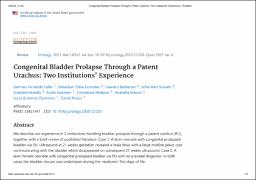| dc.contributor.author | Falke, German. | |
| dc.contributor.author | Berberian, Leandro. | |
| dc.contributor.author | Marchionatti, Sofia. | |
| dc.contributor.author | Heredia, Soledad. | |
| dc.contributor.author | Et al. | |
| dc.date.accessioned | 2023-06-16T14:42:49Z | |
| dc.date.available | 2023-06-16T14:42:49Z | |
| dc.date.issued | 2021-03 | |
| dc.identifier.citation | Urology . 2021 Mar;149:e1-e4. | es |
| dc.identifier.issn | 0090-4295 | |
| dc.identifier.uri | https://riu.austral.edu.ar/handle/123456789/2198 | |
| dc.identifier.uri | https://www.goldjournal.net/article/S0090-4295(20)31532-6/fulltext | |
| dc.description | Disponible en: https://www.goldjournal.net/article/S0090-4295(20)31532-6/fulltext | es |
| dc.description.abstract | Abstract
We describe our experience in 2 institutions handling bladder prolapse through a patent urachus (PU), together with a brief review of published literature. Case 1: A term neonate with congenital prolapsed bladder via PU. Ultrasound at 21 weeks gestation revealed a male fetus with a large midline pelvic cyst communicating with the bladder which disappeared on subsequent 27 weeks ultrasound. Case 2: A term female neonate with congenital prolapsed bladder via PU with no prenatal diagnosis. In both cases the bladder closure was undertaken during the newborns' first days of life.
Copyright © 2021 Elsevier Inc. All rights reserved. | es |
| dc.language.iso | en | es |
| dc.rights | Attribution-NonCommercial-NoDerivatives 4.0 Internacional | * |
| dc.rights.uri | http://creativecommons.org/licenses/by-nc-nd/4.0/ | * |
| dc.subject | Congenital Bladder Prolapse | es |
| dc.subject | Bladder prolapse | es |
| dc.subject | Ultrasound | es |
| dc.title | Congenital Bladder Prolapse Through a Patent Urachus: Two Institutions' Experience | es |
| dc.type | Article | es |


